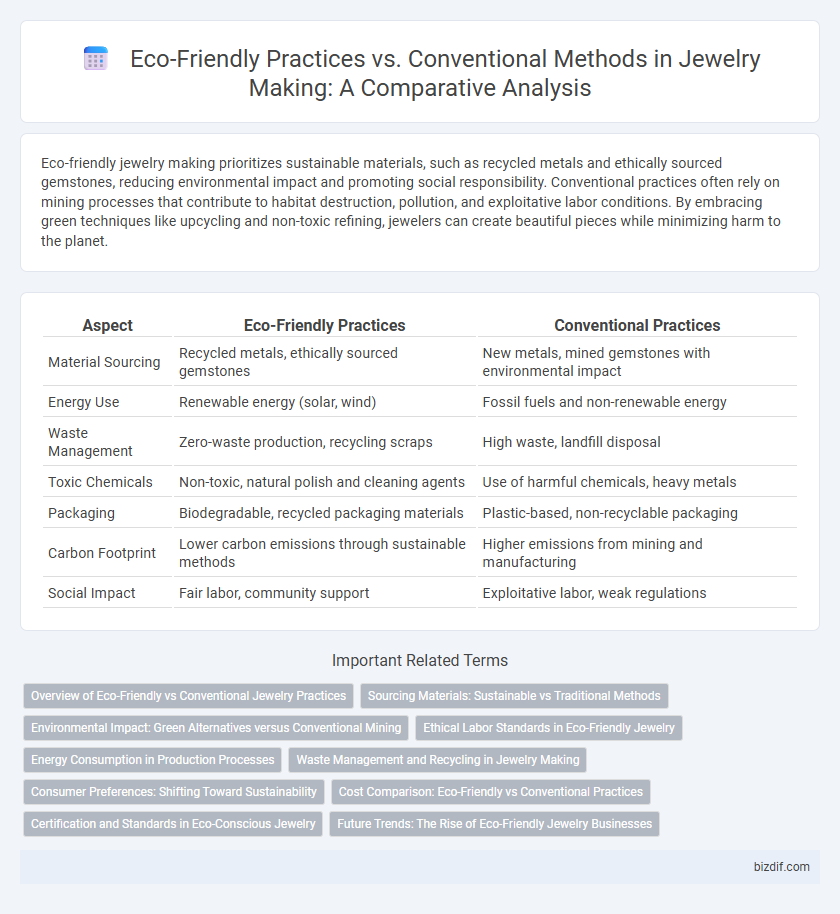Eco-friendly jewelry making prioritizes sustainable materials, such as recycled metals and ethically sourced gemstones, reducing environmental impact and promoting social responsibility. Conventional practices often rely on mining processes that contribute to habitat destruction, pollution, and exploitative labor conditions. By embracing green techniques like upcycling and non-toxic refining, jewelers can create beautiful pieces while minimizing harm to the planet.
Table of Comparison
| Aspect | Eco-Friendly Practices | Conventional Practices |
|---|---|---|
| Material Sourcing | Recycled metals, ethically sourced gemstones | New metals, mined gemstones with environmental impact |
| Energy Use | Renewable energy (solar, wind) | Fossil fuels and non-renewable energy |
| Waste Management | Zero-waste production, recycling scraps | High waste, landfill disposal |
| Toxic Chemicals | Non-toxic, natural polish and cleaning agents | Use of harmful chemicals, heavy metals |
| Packaging | Biodegradable, recycled packaging materials | Plastic-based, non-recyclable packaging |
| Carbon Footprint | Lower carbon emissions through sustainable methods | Higher emissions from mining and manufacturing |
| Social Impact | Fair labor, community support | Exploitative labor, weak regulations |
Overview of Eco-Friendly vs Conventional Jewelry Practices
Eco-friendly jewelry practices emphasize sustainable sourcing, using recycled metals and conflict-free gemstones, minimizing environmental impact throughout the production process. Conventional jewelry practices often rely on mining techniques that deplete natural resources and contribute to pollution and unethical labor conditions. Adopting eco-friendly methods supports biodiversity conservation, reduces carbon footprints, and promotes ethical supply chains in the jewelry industry.
Sourcing Materials: Sustainable vs Traditional Methods
Sourcing materials in jewelry making increasingly favors sustainable methods, such as using recycled metals and ethically mined gemstones, to reduce environmental impact and support fair labor practices. Traditional methods often rely on extensive mining that can cause habitat destruction and pollution, contributing to resource depletion. Emphasizing eco-friendly sourcing not only preserves ecosystems but also appeals to environmentally conscious consumers seeking transparency and responsibility in their purchases.
Environmental Impact: Green Alternatives versus Conventional Mining
Green alternatives in jewelry making, such as recycled metals and lab-grown gemstones, significantly reduce environmental impact by minimizing land degradation, water pollution, and carbon emissions associated with conventional mining. Conventional mining involves extensive excavation, habitat destruction, and toxic chemical use, which contribute to biodiversity loss and ecosystem damage. Embracing eco-friendly materials and sustainable sourcing promotes conservation efforts while maintaining high-quality craftsmanship in jewelry production.
Ethical Labor Standards in Eco-Friendly Jewelry
Eco-friendly jewelry prioritizes ethical labor standards by ensuring fair wages, safe working conditions, and no exploitation throughout the supply chain, contrasting sharply with many conventional practices often linked to unethical labor. Artisans involved in eco-friendly jewelry production are usually supported through transparent sourcing and certification programs like Fair Trade and Responsible Jewelry Council. This commitment not only promotes sustainability but also fosters social responsibility within the jewelry industry, appealing to conscious consumers.
Energy Consumption in Production Processes
Eco-friendly jewelry making significantly reduces energy consumption by utilizing renewable energy sources like solar and wind power, compared to conventional practices that rely heavily on fossil fuels. Techniques such as cold forging and handcrafting diminish the need for energy-intensive machinery, lowering the overall carbon footprint in the production process. Sustainable production also includes recycling precious metals, which saves up to 85% of the energy typically consumed in extracting and refining virgin materials.
Waste Management and Recycling in Jewelry Making
Eco-friendly jewelry making prioritizes waste reduction through meticulous material planning and the use of recycled metals, significantly lowering environmental impact compared to conventional practices that often generate substantial metal and gemstone scrap. Innovative recycling techniques in sustainable workshops convert precious metal offcuts and polishing dust into reusable raw materials, whereas traditional methods typically discard these as waste. Implementing closed-loop systems enhances resource efficiency, promoting circularity and reducing landfill contributions in the jewelry manufacturing process.
Consumer Preferences: Shifting Toward Sustainability
Consumer preferences in jewelry making increasingly favor eco-friendly practices over conventional methods due to growing awareness of environmental impact and ethical sourcing. Sustainable materials such as recycled metals and lab-grown gemstones are gaining traction, reflecting demand for transparency and reduced carbon footprints. This shift drives brands to adopt greener production techniques, aligning with evolving market expectations for responsible luxury.
Cost Comparison: Eco-Friendly vs Conventional Practices
Eco-friendly jewelry making often involves sourcing recycled metals and ethically mined gemstones, which can lead to higher initial material costs compared to conventional practices that rely on less expensive, mined resources with environmental concerns. While conventional methods may reduce short-term expenses, eco-friendly practices save long-term costs by minimizing waste, reducing energy consumption, and avoiding regulatory fines related to pollution. Investing in sustainable materials and processes enhances brand value and aligns with consumer demand for responsible jewelry, potentially increasing profitability despite higher upfront costs.
Certification and Standards in Eco-Conscious Jewelry
Eco-friendly jewelry making emphasizes certifications such as Fair Trade, Responsible Jewellery Council (RJC), and Kimberley Process to ensure ethical sourcing and environmental responsibility. Conventional practices often lack these rigorous standards, leading to higher risks of environmental harm and unethical labor conditions. Adopting certified eco-conscious processes promotes transparency, traceability, and sustainable resource management in jewelry production.
Future Trends: The Rise of Eco-Friendly Jewelry Businesses
Eco-friendly jewelry businesses are driving the future of jewelry making by prioritizing sustainable sourcing, such as recycled metals and ethically mined gemstones. These practices significantly reduce environmental impact compared to conventional methods that rely heavily on mining and non-renewable resources. Increasing consumer demand for transparency and environmental responsibility is accelerating the shift toward green innovation in the industry.
Eco-friendly practices vs Conventional practices Infographic

 bizdif.com
bizdif.com